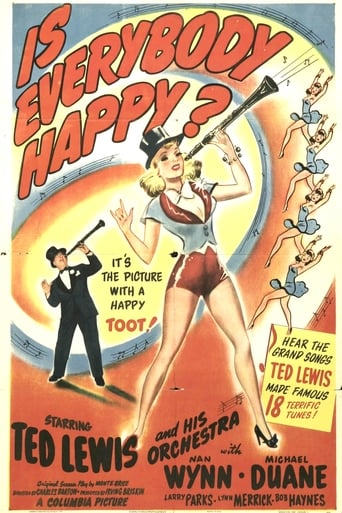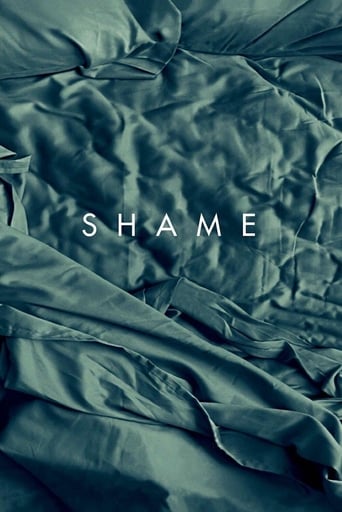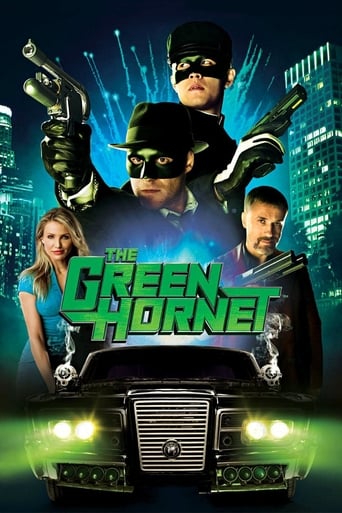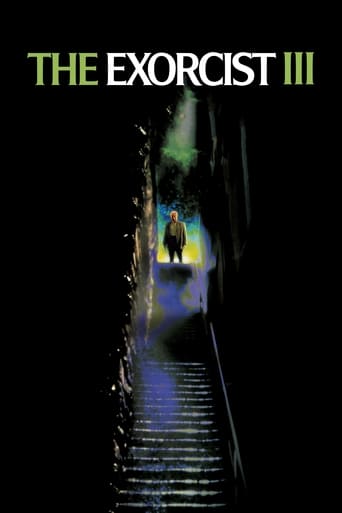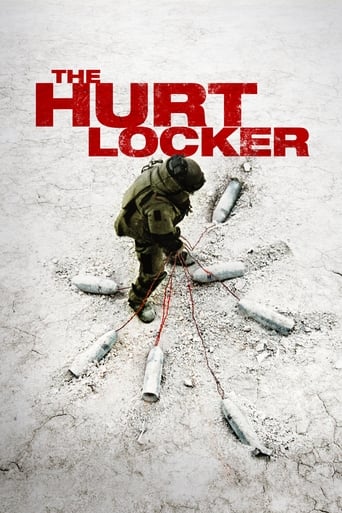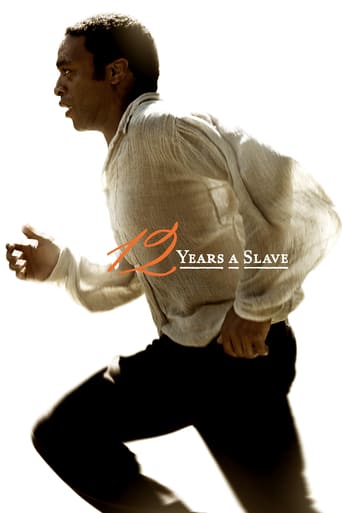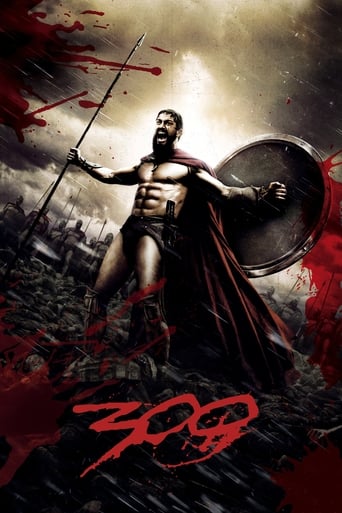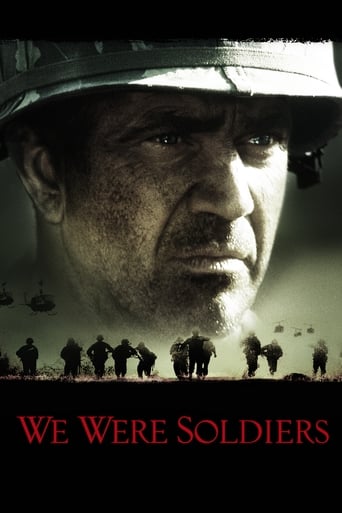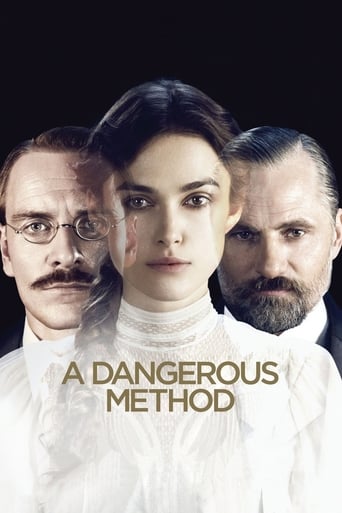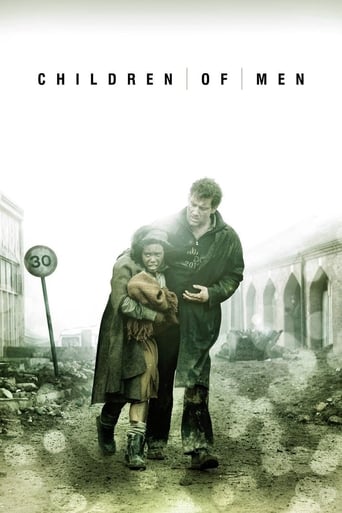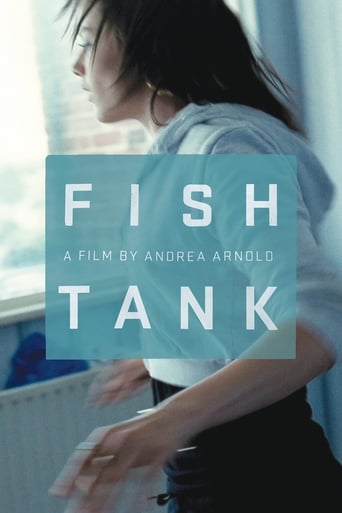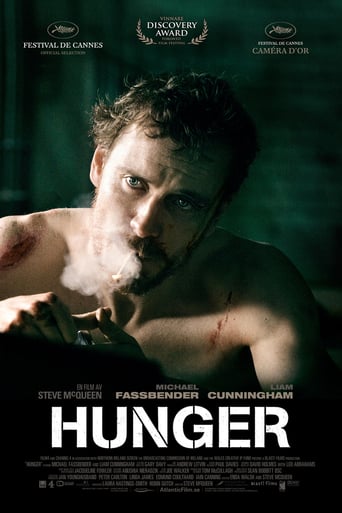


Hunger
The story of Bobby Sands, the IRA member who led the 1981 hunger strike during The Troubles in which Irish Republican prisoners tried to win political status.
-
- Cast:
- Michael Fassbender , Stuart Graham , Liam Cunningham , Helena Bereen , Brian Milligan , Liam McMahon , Karen Hassan


Similar titles
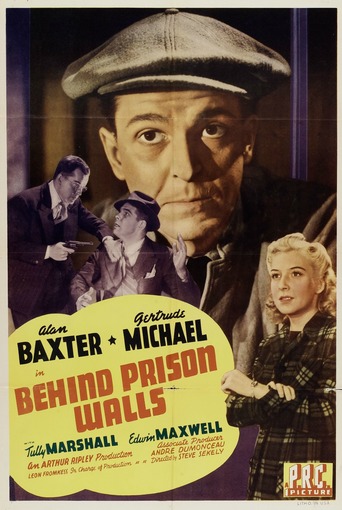



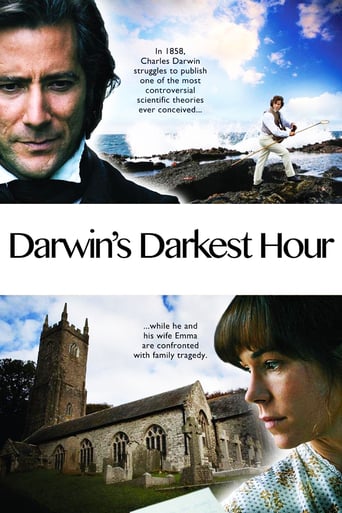
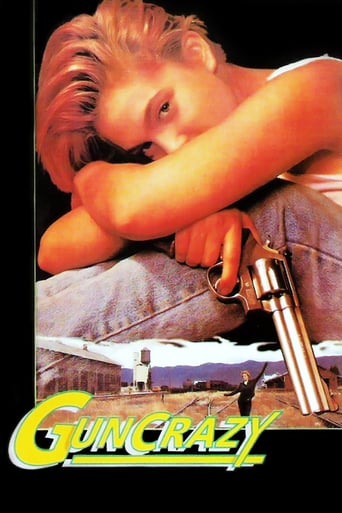
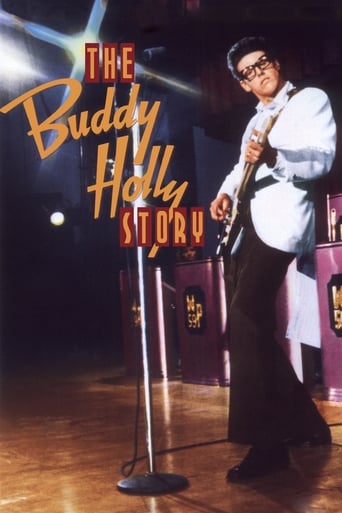
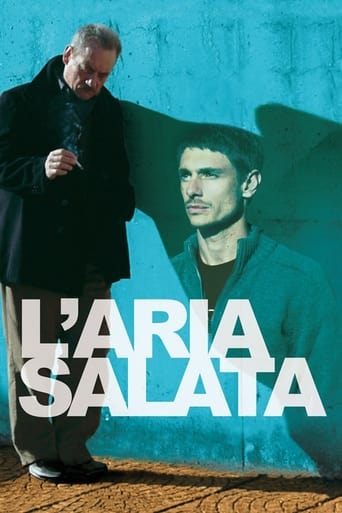
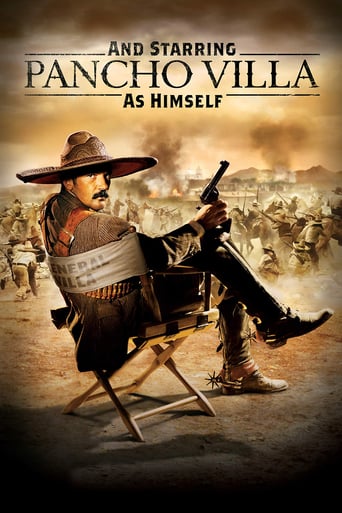
Reviews
At first rather annoying in its heavy emphasis on reenactments, this movie ultimately proves fascinating, simply because the complicated, highly dramatic tale it tells still almost defies belief.
The acting in this movie is really good.
One of the worst ways to make a cult movie is to set out to make a cult movie.
Exactly the movie you think it is, but not the movie you want it to be.
I just thought this movie was alright on my first viewing. There were a few aspects I really liked about it such as the middle scene and the depiction of the hunger strike. However, I originally disliked how attention was taken away from most of the characters introduced in the first act. Overall, it feels like an odd choice to introduce multiple characters only to have them leave the film half an hour later, doesn't it? However, after I revisited this movie a couple more times, I loved it to such great of an extent that it's now one of my favorite films of all time.Northern Ireland, 1981. After the government withdraws the political status of all paramilitary prisoners, the inmates of the Maze Prison retaliate by forming a blanket and a no wash protest, ultimately leading to a hunger strike led by one of the inmates, Bobby Sands.This movie is clearly an unconventional film due to the lack of dialogue and the plot structure. One thing I've learned from watching unconventional movies is that while they may have glaring flaws on the surface, the director might have a good reason for making the film that way. For instance, Bela Tarr and Michael Snow had good reasons for drawing out Satantango and Wavelength as much as they did and Stan Brakhage had good reasons for including no sound in most of his films. Sometimes, if I think more about aspects which seem like glaring flaws in unconventional films, it starts to make sense that a director would make their film that way. That was how I warmed up to this film.What I love about this movie is its unique story structure. I initially thought it was a traditional three-act structure. However, I make the argument that the first and the third acts are bookends to the dialogue sequence in the middle. The first act showed the failed protests and the consequences they had on both the guards and the prisoners, the second act showed a prisoner revealing his plans of a more organized protest, and the third act showed that protest in action. By featuring only one prisoner in the third act, I think the statement McQueen is making here is that the hunger strike protest worked better as, since there were less people involved, it was more organized. I initially criticized the movie for taking attention away from several of the characters introduced in the first act, but I now think that this decision helped the film.Another point which McQueen appears to be making here is that both sides are tired of the protest but are unwilling to back down. This is conveyed in numerous places such as how Raymond Lohan can be seen cleaning his bloodied knuckles a couple times in the film. There's also a powerful moment where a prison guard can be seen crying while the rest of the guards beat numerous prisoners with batons. This implication also extends to different prisoners such as Gerry as his emotions convey fright and determination as he smears his faeces on the wall for the protest. These scenes add a layer of humanity to this film.It's also hard not to talk about the number of memorable moments found in the film such as the captivating and well-acted dialogue sequence in the middle which feels like the film's centerpiece. Besides that scene, however, dialogue feels unimportant to absorbing the rest of the film and its characters, so the mostly dialogue free film seems to thrive on this restriction. There's also other chilling moments outside of the dialogue such as when Lohan is killed by an IRA assassin in front of his catatonic mother who seems unaware of her surroundings. Another great scene is the long, stationary, and expressive shot of a prison attendant cleaning up multiple puddles of urine. Finally, it's hard not to mention the painfully realistic depiction of Sands' hunger strike. To film that sequence, Fassbender went on a diet of less than 900 calories for 10 weeks to give the illusion of starvation. This sequence was filled with clever moments such as a montage of Sands' food servings slowly getting smaller as he inched closer to death, images and sounds of flying birds as he convulsed in pain, and what I think was his hallucination near the end of his strike.In conclusion, I think this film is a masterpiece, and it's, currently, my favorite film of the 2000's. It's also one of the best debut films I've seen before. While this film can be hard to watch due to the brutal and disturbing content found throughout, it remains so compelling for a variety of reasons that you can't turn away from the picture. Not for the faint of heart, but a must-see for older viewers.
Hunger shows us Irish Republican Army (IRA) activists, whom prisoners demand to be treated as political prisoners (their goal was to separate Northern Ireland from the UK and re-emigrate to Ireland), receiving inhuman treatment, being humiliated and having to cope with daily violence, led by Bobby Sands (Fassbender), decide to go on a hunger strike to have their orders met. Not deepening in the political aspect of the story, Steve does show the dehumanization suffered by both prisoners and prison guards, beautifully done, with incredible takes, marvelous dialogues, it's a heavy film that is not easy to digest, but it's worth it to be seen. Besides, Fassbender still delivers a performance like Christian Bale in The Machinist (2004), leaving you totally paralyzed.
Consider how Steve McQueen captures a character's morning in his debut feature film Hunger. He uses extreme close-ups to gradually unveil the strict routine of getting ready to go to work. The man is silent and efficient; he tucks a napkin into the folds of his shirt like a scientist slipping into his lab coat, and observes the food as more or less one of the many requirements of the experiment. We see him silently check under his car for a bomb, and nervously glance along the empty street. A POV spies on him from behind a curtain - it's his wife, who we realise must also undergo the same agony each morning, gripping her hands tightly together as he turns the key in the ignition. He is Maze prisoner officer Raymond Lohan, who sits alone in the cafeteria and does not indulge in locker room talk. What we observe is the learned, robotic discipline of a man who cannot afford to make mistakes or become emotionally invested in his work. McQueen offers another close-up of Lohan against a mirror, a face straining in pain. And only after have we become invested into his life and curious of his struggles does the film reveal bloody knuckles, and the revelation that another person somewhere else is in much more pain than he is. By the time McQueen returns to the same sink half an hour in, our feelings and sympathies have been changed because of what we have witnessed. For years before hitting the big screen McQueen made short films, many of which were looped as exhibits in various art galleries and museums. These roots are evident in Hunger, which eschews classical narrative and storytelling and instead opts to wade into the vague and often ill-defined territory of art film, preferring enduring images over explanations. Much of the first half of the film is filled with moments that could define it: the camera swooping over the sh*t-stained walls and finally descending onto the dishevelled figure of Bobby Sands, the slow, silent burn of a hallway leaking puddles of the protester's urine, the way the world slows down as a wall separates the beatings and a lone, sobbing prison guard, singled out for his youth and naivety. It's brutal, senseless violence, as evidenced by the wall of sound and pain that the prisoners are marshalled through, or the way water droplets hit the face of the lens as they are forcibly bathed. But as much as McQueen strives for realism with his hand-held and guttural sound design, he can't help but aestheticise until it's not merely tragedy, but grandiose tragedy. Sands has had plenty of time, and turned his own faeces into a swirling piece of art. A hole in the cell window grating allows a shaft of white light to peek through, and a prisoner marvels at a fly that crawls upon his fingertips, not merely an insect but a symbolic representation of the freedom he craves. The treatment of the final days of the martyr Sands outdoes all these. The most discussed segment of the film are the two unbroken shots of the conversation between Fassbender and Cunningham, and for good reason. Like the better cinematic priests (think Brendan Gleeson in Cavalry, or any of the religious figures in Doubt), Cunningham is inserted not as a moraliser but as his own character, able to understand the complexity of the situation and offer his own perspective. Before they descend into rhetoric they engage in small talk, as Moran teases (he doesn't object to the sacrilege of the bible for a smoke either), and McQueen is able to make us understand that this is a routine they have endured before, and that through the seventeen minutes they always come to the same impasse. Moran sympathises and does not simply condone; although Catholic doctrine states that suicide is a sin, he is more interested in Sands' end goals and well-being. Forget the eternal suffering of your soul, what about your physical body and mind now? The pair are so well-versed in the exchange that they are on the verge of cutting each other off and jumping to the next line, or at least Cunningham's Moran is, sensing that his time is running out to save this man's life. Although much has been said about the symbolic meaning behind Sands' story, the visible result is that it paints him as a man of utmost conviction, able to shoulder the burden and responsibility of darker deeds for the greater good of others. But a story simply isn't enough. There is a lot more context here, and the film deliberately avoids engaging with the historical and political baggage of the situation, diminishing it to personal struggle. It depicts the increasingly fragile state of Sands' body, dissolving untouched meal trays onto each other, shoving the camera up close and asking us to cringe and avoid averting our eyes. McQueen doesn't filter Sands' last stand through the lens of a wider protest, or evoke the desperation of a group of men resorting to their remaining weapon, but reduces it to body horror, and renders the iconic visage of Sands into a withered metaphor for determination and conviction. Fassbender may be good at this, but he lacks the symbolic connection to the thirty thousand Irish residents who voted him into the Fermanagh and South Tyrone parliamentary seat during the hunger strike, so he's merely a physical body in decay. Not that this deters McQueen, however. In his close he all but denounces the stylistic precedent already established, and resorts to burying Sands in myth, superimposing flights of birds over his body, and bathing him in angelic light to transform his plight into rapturous martyrdom. No doubt Cool Hand Luke and Michelangelo's Pietà were consulted. And finally McQueen stumbles clumsily into formalism, revealing a younger Sands surveying the piety of the almost deceased older Sands, yet it almost seems to be a look of pity.
The Film is like an oratorio fort he death of Bobby Sands in a British prison in Northern Ireland in 1981 after a sixty-six day hunger strike. He was only the first one to die in a series of nine and it took nine lives to be wasted for the British government and Margaret Thatcher to yield on all the demands of the prisoners except the status of political prisoners.The film does not rewrite history and we are supposed to know this most abominable episode of the inglorious war in Northern Ireland. The British had no future there but after this dramatic event the British had lost any moral or political claim in Northern Ireland which was both part of Ireland and not British at all, except as a brutal colony.The film just gives us a believable vision of this horror: the refusal to wear prison uniforms, hence the locking up of the prisoners in absolutely unbearable semi-isolation with nothing to wear but a blanket, thence the refusal to wash and the frightening painting of the cells by the prisoners with their own excrement. Then they had to be taken one by one to be forcefully shaved and washed up in a bathtub with a lot of violence and beating up. The only right they had was that of common criminals: a visit by relatives every so often, or rather every so rarely. Then they accepted to put on a pair of black trousers: the only moment when they were dressed. The hunger strike on March 1, 1981 was the most drastic decision and the film tries to listen to Bobby Sands' arguments when he discusses them with his priest. We have to listen to those of the priest too, essentially that it was vanity that moved them because they were looking for martyrdom and if they died, the priest said, it would only be suicide. And we know what that means in the Catholic Church.Then the visual depiction of Bobby Sands' death is very graphic. The hatred of some of the nurses and auxiliaries was obvious, including their having UDA tattooed on their fingers so that the prisoners could know where they stood and this UDA capital letters were tattooed on the hitting phalanxes of the fist. The violence was not only real but also symbolical. In fact the film contains little dialogue because the objective is to show the humiliation and the violence and nothing else on one hand and the resistance on the other hand. On one hand you had animals of prey torturing their prisoners. On the other hand you had prisoners reduced to be animals and building their dignity in pushing it to the end of the line, to death if necessary and it was necessary for nine of them.An extremely disturbing film showing how low the British fell in this war and they even stooped too low to be able to conquer anything. They just failed and were defeated.Dr Jacques COULARDEAU

